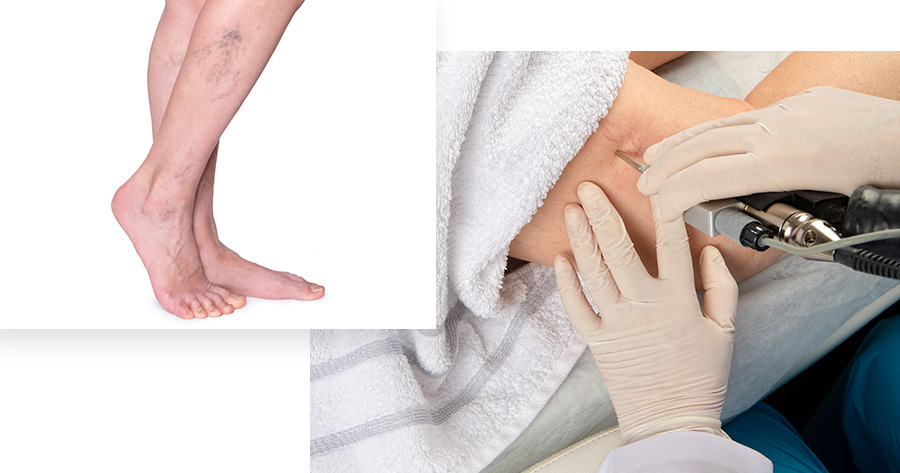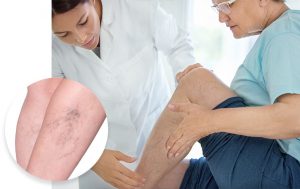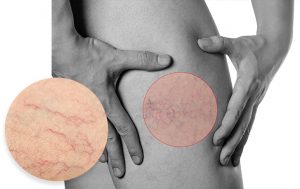Vein Conditions We Treat at Advanced Dermatology P.C.
Are you or a loved one living with a vein-related issue causing mild to moderate symptoms or decreasing overall confidence? Our team at Advanced Dermatology, PC is here to help.
While there are many causes of a vein condition in your lower legs, genetics, and lifestyle play the most substantial role in their development. Standing for extended periods increases pressure in the lower areas of your body, while age causes veins to lose their elasticity, making them stretch.
For some people, spider and varicose veins can be a painful problem, but in most cases, treating visible veins is more of a cosmetic concern.

Whether searching for a treatment to relieve pain and discomfort caused by a vein condition, such as varicose veins, or simply hoping to reduce the appearance of small red or blue spider veins on your legs, we provide innovative solutions to help you feel and look your best.
Continue reading to learn more about the vein conditions we treat.
Common Vein Conditions
Several vein conditions affect people of all ages and backgrounds, ranging from minor cosmetic concerns to more serious medical issues. The most common vein conditions are telangiectasia, reticular, and varicose.
What Is Telangiectasia?
Telangiectasia, also known as spider veins or broken blood vessels, is a common medical condition characterized by the dilation of small blood vessels near the skin’s surface.
These blood vessels, which can appear as red, blue, or purple lines or clusters, are typically very fine and get their nickname, “spider veins,” by their web-like appearance just below the skin’s surface.
Telangiectasias most commonly occur on the face, especially on the nose and cheeks, but they can also appear on other parts of the body, such as the lower legs and ankles.
Several factors can contribute to telangiectasia’s development, including
- Genetics
- Prolonged or excessive sun exposure
- Aging
- Rosacea
- Trauma to the skin
While telangiectasia is considered a cosmetic concern, it can be bothersome for some, especially if the affected areas are widespread or discomfort is experienced.
What Are Varicose Veins?
Similar to spider veins, varicose veins are swollen, twisted, and often enlarged veins that most often affect the legs. They can appear blue or dark purple and are often visible just beneath the surface of the skin.
Varicose veins develop when the one-way valves inside veins become weak or damaged, leading to blood pooling in the veins, causing them to stretch and bulge.
There are various reasons you may develop varicose veins, including
- A family history of varicose veins
- Age
- Gender: Women are more likely than men to develop them
- Pregnancy
- Obesity
- Prolonged standing or sitting
Unlike spider veins, varicose veins are more severe and often include moderate symptoms that may include pain, swelling, or itching.
Typically, varicose veins worsen over time. While often considered a cosmetic concern, they can cause discomfort and, in some cases, more severe complications like blood clots or ulcers when left untreated.
What Are Reticular Veins?
Reticular veins, also known as feeder veins, are connected to the larger, deeper veins in the body and play a role in returning blood from the superficial veins to the deeper venous system.
They are smaller than varicose veins but larger than telangiectasias, typically blue or green. They may appear in a web-like pattern just below the skin’s surface.
Reticular veins are usually found in the legs and thighs but can be found in other parts of the body.
These veins may not cause significant symptoms, but some individuals may experience mild discomfort, aching, or itching in the areas where these veins are present.
Reticular veins can develop due to similar factors contributing to spider or varicose veins, such as genetics, aging, hormonal changes, and prolonged sitting or standing.
Symptoms and Diagnosis of Common Vein Conditions
Diagnosing common vein conditions, including spider, reticular, or varicose veins, involves a combination of a physical examination and, in some cases, imaging tests.
The first step in diagnosing a vein condition is often to review your medical history, followed by a physical assessment and symptom review.
A thorough examination is crucial to assess your veins’ appearance and the extent of your vein issue. During this examination, they may ask you to stand, sit, or raise your legs to observe how the veins change with position.

They will also check for common symptoms, including
- Aching or pain in the legs, often worse after long periods of standing or sitting.
- Swelling
- Itching
- A burning sensation near the affected veins
- Cramping
- Muscle fatigue
- Skin changes, such as darkening or inflammation around the veins
A duplex ultrasound is often used to confirm a diagnosis and provide more detailed information about the affected veins. This non-invasive test uses sound waves to create images of the blood flow in your veins and can assess the function of the valves within the veins.
In rare cases or if there are concerns about deep vein thrombosis (DVT) or other vascular conditions, additional tests such as a venogram or CT scan may be recommended.
How Can I Prevent a Vein Condition?
While not completely preventable, you can reduce your risk of developing vein conditions like varicose and spider veins by adopting a healthy lifestyle and implementing specific measures to improve vein health.

Genetics play a significant role in vein conditions. Still, there are several steps you can take to reduce your risk and promote good vein health, including
- Regular physical activity
- Maintaining a healthy weight
- Elevating your legs
- Staying hydrated, sticking to a healthy diet, and limiting salt intake
- Moving your legs regularly, especially during prolonged periods of sitting or standing
- Managing chronic conditions, such as diabetes or high blood pressure
- Quitting smoking
If you have a family history of vein conditions, you should speak with your provider about the most effective preventative measures for your unique situation.
Effective Treatment and Management of Vein Conditions
If you or a loved one are living with varicose, spider, or reticular veins, treatment can help reduce their symptoms and minimize their appearance.
At Advanced Dermatology, PC, we offer the following treatment options for common vein conditions:
CoolTouch Endovenous Laser Ablation
With CoolTouch Endovenous Laser Ablation (CTEV), a small single-needle incision is made, and a fiber is inserted into the affected vein. The laser is activated, and the fiber gently heats and safely closes the vein. Once the vein is closed, blood that was circulating through this vein is rerouted to healthy veins while the varicose vein vanishes.
Sclerotherapy
This minimally invasive procedure involves injecting sodium tetradecyl into the problem veins. The solution irritates the vein’s lining and causes it to close off.
Without blood, the vein is less visible over time. It disintegrates and is reabsorbed. Sclerotherapy can treat telangiectasia, reticular veins, and small varicose veins.
The number of treatments needed depends on the severity of the problem. On average, most patients need 2 to 4 treatments focusing on treating veins in size order from largest to smallest.
Phlebectomy
This minimally invasive surgical procedure involves making small incisions over the affected veins. From there, a special hook-like tool removes or “strips” the problematic veins from the leg.
This procedure is often performed with other treatments like Endovenous laser therapy (EVLT) or radiofrequency ablation to provide comprehensive relief from varicose veins and improve circulation.
Frequently Asked Questions
What causes red veins to appear on a woman’s skin?
Red veins, often called spider veins or telangiectasia, can appear on a woman’s skin for various reasons. The most common causes include genetics, hormonal changes (such as pregnancy or menopause), prolonged sun exposure, aging, and skin conditions like rosacea.
Are blue veins a sign of a serious medical condition?
The short answer is no. Blue veins on the skin are typically not a sign of a serious medical condition. They are usually veins close to the skin’s surface and appear blue or greenish due to how light interacts with the skin. However, if blue veins are accompanied by symptoms like pain, swelling, or skin changes, you should visit us for further evaluation.
How can I prevent the appearance of enlarged veins?
There is no complete way to avoid enlarged veins, but there are ways to lower the risk of developing them.
To reduce the risk of developing enlarged veins, such as varicose veins or spider veins, maintain a healthy lifestyle by exercising regularly to promote good blood circulation, maintaining a healthy weight to reduce pressure on veins, avoiding tight clothing that restricts blood flow, and elevating your legs when possible to encourage blood flow back to the heart.
If you have a family history of vein conditions or are at risk, consider wearing compression stockings to support vein health.
Is there a difference between red and blue veins in terms of treatment?
Typically no, there is no difference between red and blue vein treatment.
Both can be treated with procedures like sclerotherapy or laser therapy. However, the specific treatment approach may vary depending on the size, location, and severity of the veins, as well as individual patient factors and preferences.
Do hormonal changes during pregnancy or menopause increase the risk of vein issues?
Yes, hormonal changes during pregnancy and menopause can increase the risk of vein issues, particularly the development of varicose and spider veins.
During pregnancy, hormonal shifts, increased blood volume, and the pressure of the growing uterus can lead to the dilation of veins and the weakening of vein walls.
Similarly, hormonal fluctuations associated with menopause can contribute to vein problems, as decreased estrogen levels may affect vein elasticity.
